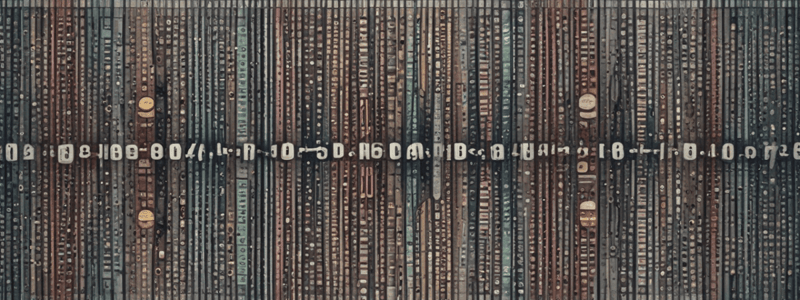Podcast
Questions and Answers
What is the first step when converting a decimal number to binary?
What is the first step when converting a decimal number to binary?
- Subtract 1 from the decimal number
- Check if the decimal number is greater than 128 (correct)
- Divide the decimal number by 2
- Convert the decimal number to hexadecimal
What is the purpose of using hexadecimal in IPv6 addresses?
What is the purpose of using hexadecimal in IPv6 addresses?
- To make it easier to read and write (correct)
- To increase the security of the address
- To make it compatible with IPv4 addresses
- To shorten the length of the address
How many bits are in an IPv6 address?
How many bits are in an IPv6 address?
- 256 bits
- 512 bits
- 64 bits
- 128 bits (correct)
What is the advantage of using hexadecimal over binary?
What is the advantage of using hexadecimal over binary?
What does a router understand?
What does a router understand?
What is the result of subtracting 128 from 168?
What is the result of subtracting 128 from 168?
What is the purpose of the binary number system?
What is the purpose of the binary number system?
What is the decimal equivalent of the binary number 10101000?
What is the decimal equivalent of the binary number 10101000?
What is the radix of the Binary Number System?
What is the radix of the Binary Number System?
What is the position value of the 7th bit from the right in a binary number?
What is the position value of the 7th bit from the right in a binary number?
What is the decimal equivalent of the binary number 11000000?
What is the decimal equivalent of the binary number 11000000?
How do you convert a binary number to decimal?
How do you convert a binary number to decimal?
What is the purpose of the binary positional value table?
What is the purpose of the binary positional value table?
What is the first step in converting a decimal number to binary using the binary positional value table?
What is the first step in converting a decimal number to binary using the binary positional value table?
What do you record in the 128 positional value if the decimal number is less than 128?
What do you record in the 128 positional value if the decimal number is less than 128?
What is the resulting IPv4 address after converting 192.168.11.10 to binary?
What is the resulting IPv4 address after converting 192.168.11.10 to binary?
What is the base of the decimal numbering system?
What is the base of the decimal numbering system?
What is the main purpose of using dotted notation in binary addresses?
What is the main purpose of using dotted notation in binary addresses?
What is the total number of bits in a binary address?
What is the total number of bits in a binary address?
What is the term for a digit representing different values depending on its position in a sequence of numbers?
What is the term for a digit representing different values depending on its position in a sequence of numbers?
What is the total number of sections in a binary address?
What is the total number of sections in a binary address?
What is the value of the 'Thousands' position in the decimal positional notation system?
What is the value of the 'Thousands' position in the decimal positional notation system?
What is the term for a string of 8 bits in a binary address?
What is the term for a string of 8 bits in a binary address?
What is the main advantage of using binary addressing in hosts, servers, and network equipment?
What is the main advantage of using binary addressing in hosts, servers, and network equipment?
How many bits are represented by a single hexadecimal digit?
How many bits are represented by a single hexadecimal digit?
How many hexadecimal values make up an IPv6 address?
How many hexadecimal values make up an IPv6 address?
What is each four hexadecimal character group referred to as?
What is each four hexadecimal character group referred to as?
What is the first step in converting decimal numbers to hexadecimal values?
What is the first step in converting decimal numbers to hexadecimal values?
What is the result of converting 168 to hexadecimal using the three-step process?
What is the result of converting 168 to hexadecimal using the three-step process?
What is the first step in converting hexadecimal numbers to decimal values?
What is the first step in converting hexadecimal numbers to decimal values?
What is the result of converting D2 to decimal using the three-step process?
What is the result of converting D2 to decimal using the three-step process?
How many bits are in each group when converting hexadecimal numbers to decimal values?
How many bits are in each group when converting hexadecimal numbers to decimal values?
What is the purpose of the three-step process in hexadecimal conversions?
What is the purpose of the three-step process in hexadecimal conversions?
What is the advantage of using the hexadecimal number system?
What is the advantage of using the hexadecimal number system?
Study Notes
Binary Number System
- Binary numbering system consists of 1s and 0s, called bits
- Decimal numbering system consists of digits 0 through 9
- Hosts, servers, and network equipment use binary addressing to identify each other
- Each address is made up of a string of 32 bits, divided into four sections called octets
- Each octet contains 8 bits (or 1 byte) separated by a dot
Decimal to Binary Conversion
- To convert a decimal number to binary, start in the 128 position (the most significant bit)
- If the decimal number is equal to or greater than 128, record a binary 1 in the 128 positional value and subtract 128 from the decimal number
- Repeat these steps through the 1 positional value
Binary Positional Notation
- Positional notation means that a digit represents different values depending on the “position” the digit occupies in the sequence of numbers
- The decimal positional notation system operates as shown in the tables below
- Radix: the base of a system of numeration
- In binary positional notation, every 4 bits is represented by a single hexadecimal digit
IPv4 Addresses
- Routers and computers only understand binary, while humans work in decimal
- It is important to gain a thorough understanding of these two numbering systems and how they are used in networking
- IPv4 addresses are 32 bits in length and divided into four sections called octets
- Each octet contains 8 bits (or 1 byte) separated by a dot
Hexadecimal Number System
- Hexadecimal is a base sixteen numbering system, using the digits 0 through 9 and letters A to F
- It is easier to express a value as a single hexadecimal digit than as four binary bits
- Hexadecimal is used to represent IPv6 addresses and MAC addresses
- IPv6 addresses are 128 bits in length
Hexadecimal Conversions
- To convert decimal numbers to hexadecimal values:
- Convert the decimal number to 8-bit binary strings
- Divide the binary strings in groups of four starting from the rightmost position
- Convert each four binary numbers into their equivalent hexadecimal digit
- Example: 168 converted into hex using the three-step process
- 168 in binary is 10101000
- 10101000 in two groups of four binary digits is 1010 and 1000
- 1010 is hex A and 1000 is hex 8, so 168 is A8 in hexadecimal
Hexadecimal to Decimal Conversions
- To convert hexadecimal numbers to decimal values:
- Convert the hexadecimal number to 4-bit binary strings
- Create 8-bit binary grouping starting from the rightmost position
- Convert each 8-bit binary grouping into their equivalent decimal digit
- Example: D2 converted into decimal using the three-step process
- D2 in 4-bit binary strings is 1101 and 0010
- 1101 and 0010 is 11010010 in an 8-bit grouping
- 11010010 in binary is equivalent to 210 in decimal, so D2 is 210 in decimal
Studying That Suits You
Use AI to generate personalized quizzes and flashcards to suit your learning preferences.
Related Documents
Description
Test your skills in converting binary numbers to decimal. Practice calculating positional values and converting binary numbers to decimal numbers.




